Maretron SMS100, advanced NMEA 2000 monitoring via cell texts
Two recent experiences make me particularly excited about the Maretron SMS100 announced today (and already shipping). During the trip north I learned to appreciate the sophisticated “Alert” features built into Maretron’s various NMEA 2000 displays and I also enjoyed some benefits of the Siren Marine cellular monitoring system. In fact, Gizmo’s refrigerator currently contains two temperature sensors, a Maretron probe for on board monitoring and a Siren probe so I can keep an eye on the system from afar (even from Korea, by gosh). While the standalone and economical Siren system will definitely remain appropriate for some boats (and Maretron probably has an SMS learning curve to climb), I’m really looking forward to having virtually unlimited N2K monitoring on my phone…
So let’s take a look at what Maretron terms Alerts because they are usefully sub-categorized into Alarms and Warnings. An alert can be created for any value in the system based on data “trigger” conditions such as High, Low, Inside/Outside Radius, On/Off State, Direction and Time. An alarm based on a predetermined time from an N2K source like a GPS might otherwise be known as an alarm clock 😉
There are also a few special triggers like GPS Quality and the Anchor Watch alert that pairs with the DSM250 screen above (which is also available on the 250’s much less expensive little brother, the DSM150). There are arguably better anchor alarms — like the Vesper WatchMate AIS with its plotting feature or the Boat Monitor app that let’s you input the bearing and distance to your actual hook instead of creating a radius around where the boat first settles — but I’ve gotten very fond of Maretron’s. Probably the main reason is that Gizmo now has an ALM100 Alarm Module mounted on the main panel near my berth and that sucker can bring me up from the deepest sleep.
Besides blasting an audible alarm or warning (if I want), Maretron alerts also flash on whatever DSM screen is active, as shown above left. A tap on the enter button takes you to the screen above right, where you can quickly mute the sound and where you’ll also see some of the sophistication underlying the whole Alerts feature. The Description and Location, for instance, are fully customizable fields that carry themselves throughout the system, including the SMS100 text messages
I used the DSM250 emulator that is part of the free N2KAnalyzer program to make the screens above illustrating the Alert creation process (clockwise from top left). Note how they have a priority value so that if more than one is active, the right one shows on screen and the ALM100 makes its particular sound (from a choice of six). Note too how the whole Alerts system has four modes (including disabled) so, for instance, it’s easy to arm Gizmo’s navigation light low current and block temperature alarms by simply setting the mode to underway. A user can also specify which Annuciators respond to a specific alert, so I can keep my middle of the night anchor watch to myself instead having the fly bridge ALM100 also go off.
But probably the hardest parameters to get one’s head around are the Re-trigger, Set, and Clear time periods. The former is simply an anti-distraction setting as it just re-fires an already Accepted alert if the condition remains the same for a certain period of time (leaving it at 0 leaves it off). Meanwhile the above diagram — found, like many of these screens, in the DSM250 manual you can download here — neatly illustrates the use of Set and Clear delays. The values are sort of like dampening on instruments and they are also more ways that Maretron lets you hone alerts until they work exactly as they should. In my experience boat alarms that go off too often when they’re not really needed get turned off permanently.
As for the SMS100 itself, it’s certainly neat that it has a display because of its DSM association. That screen above, for instance, shows not only signal strength but also recent incoming texts so you can easily test both outgoing and incoming transmission. And I like the sound of a six frequency band modem supporting 2G GSM/GPRS/EDGE and 3G UMTS/HSDPA/HSUPA protocols because that covers so much of the cellular soup. But I wonder if Maretron’s plan to have users or installers provide their own SIM cards will cause difficulties. It makes sense on a global basis, but then again I know that Siren Marine has done a lot of trouble shooting to make their SIM cards mostly trouble free.
The SMS100’s ability to process text commands is also paltry compared to the Siren. As shipped users will only be able to text it a “Status” message and they will only get back the info seen below. However, Maretron tells me that eventually we’ll be able to design custom commands on a DSM that will not only call forth any info on the system but also permit actual control commands like DCR100 digital switching via phone. I’ve always fancied the idea of turning on boat lights before taking the tender out into a dark anchorage, but I’ve resisted having to install single purpose gadgetry to do it. Looks like I won’t have to. What can you imagine doing with Maretron’s powerful system?


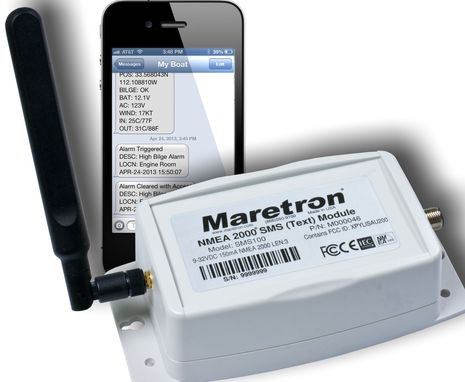
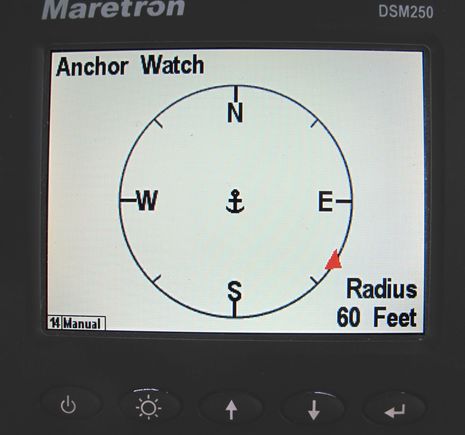
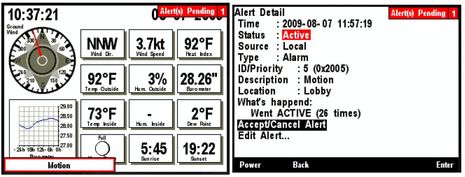
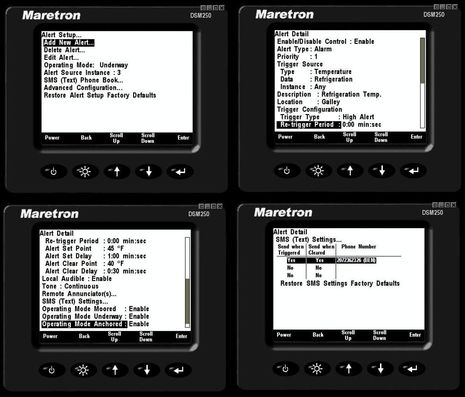
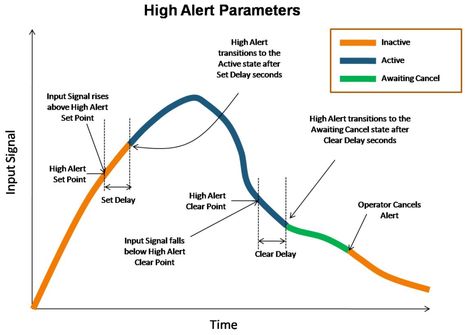
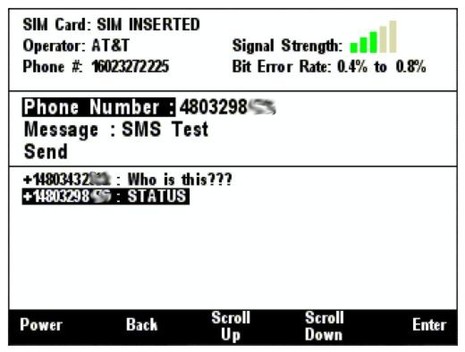
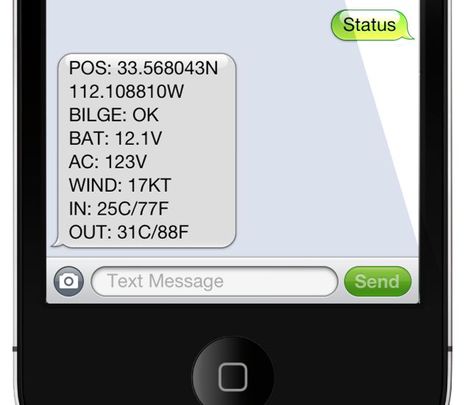
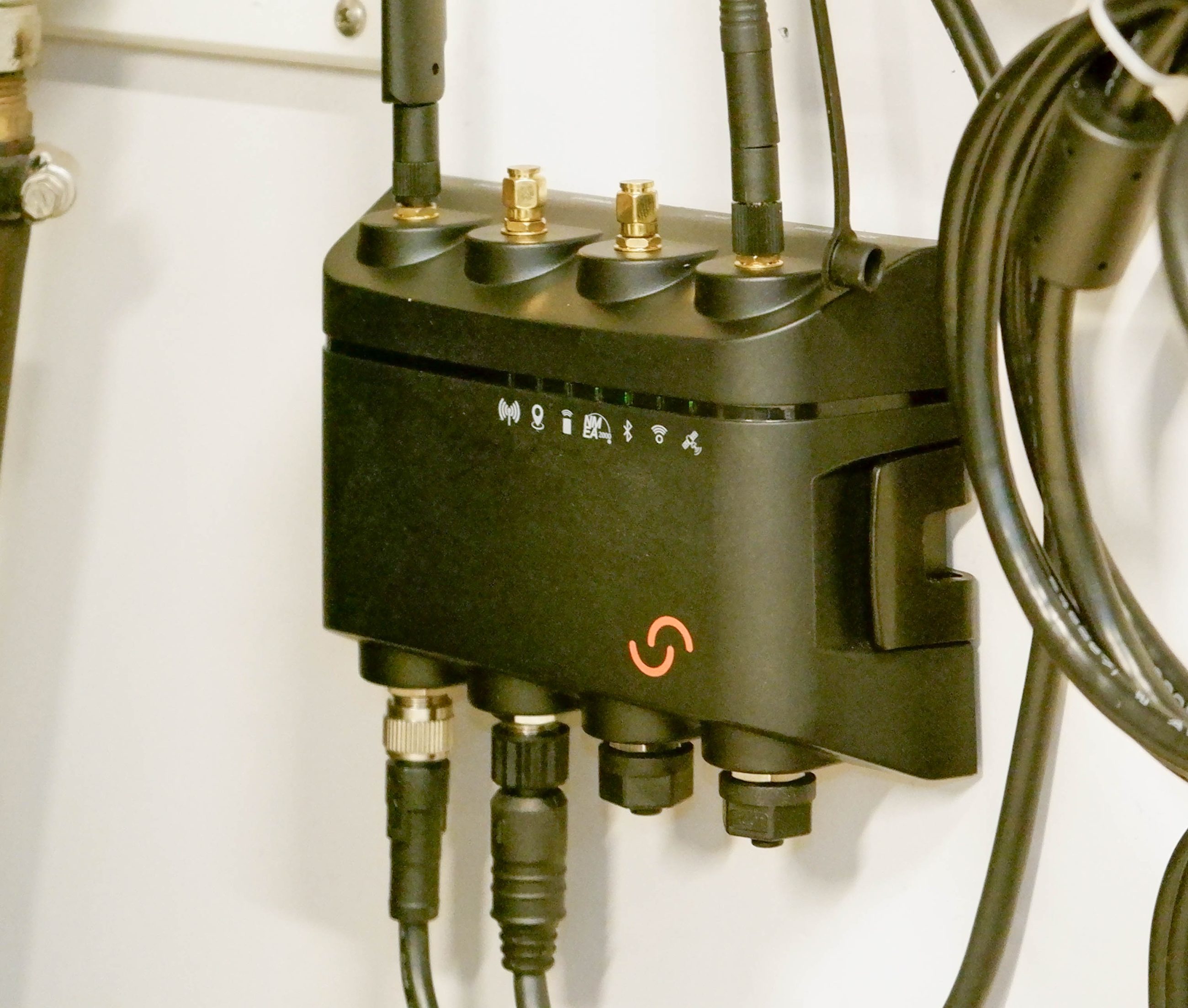










PS for the sake of context: Note that the Empirebus N2K digital switching system now associated with Raymarine includes GSM texting ( http://goo.gl/EZeza ) and that Garmin could probably add N2K monitoring easily to its GDL40 cellular weather transciever ( http://goo.gl/P0fVg ) which costs a fraction of the SMS100.
I must be missing something here. Does this “thing” require its own cellular account? It would seem so since it apparently has a SIM card installed. Can it “share” an existing cell phone account, since all it seems to do is SMS, perhaps a half-second data burst over the network.
Can the device (and/or account) also be used for remote monitoring of other things, such as an network camera with IP address, just as an example?
All these things that require monthly subscriptions add-up fast and adding another cell account is not high on my list of priorities.
Are there SMS-only cell accounts available cheaply? I believe the Kindle reader, for example, has essentially free 3G imbedded service with no subscription charges. Of course, those generate income whereas Maretron only profits once, from the sale of the device itself.
Do they offer a WiFi alternative so a SIM card and account would not be essential, for those of us who only need to get alerts while docked where there’s WiFi available (at dock or on boat WiFi network). Also, how does it send an alert if you are out of cell service range? A stored alert for high bilge water is not useful two days later.
It seems like the redundancy of WiFi or Bluetooth (or even satellite) would be mandatory for a device upon which you depend on for critical alerts, otherwise it’s just a toy for inshore use only. Hell, I’m just a lake boater, and about 85% of where I boat has no cell service at all.
That is an amazingly expensive hammer ($700) for this simple nail. You can send a text via email quite simply. Why have this piece of hardware and a separate SIM? Alternatively, this looks like something that a small app on your phone and Chetco’s much less expensive n2k interface could do quite well.
Good questions, Karl. Cellular boat monitoring products typically have their own SIM card, phone #, and account. Siren Marine, for instance, provides service for $180 a year with unlimited messages, or $18/month.
Maretron recommends AT&T service but says the SMS100 will work with many cards. They are sending me a unit to test so I bought an empty AT&T GoPhone prepaid card for a few dollars on Amazon, because I have no local AT&T store and they don’t seem willing to sell just the card online. But hopefully I’ll be able to activate it online and can either go with no prepaid plan and pay 20 cents per message or buy a bundle of 200 for $5 a month. Info here:
http://www.att.com/shop/wireless/plans/prepaidplans.html
The Maretron SMS and other GSM monitoring products like Siren Marine and Cobra’s C-Pod Security system work with text only. Maretron does in fact offer a higher-end system with off boat video, but it’s a lot more complicated and expensive.
I ran Siren Marine 24/7 from South Carolina to Maine and while I definitely cruised beyond cellular sometimes, I don’t think I ever anchored or moored and went ashore anywhere that I couldn’t check the boat via a text message. Had it dragged or been stolen, I’m pretty sure that the Siren system would have let me know and would have tracked the boat.
But that situation will likely change when I cruise further east in Maine and even my harbor is tough on GSM messaging even though AT&T voice/email works fine here. I plan to run both Maretron and Siren and will report on the results.
Hi Steve, I certainly won’t argue that $700 for a waterproof NMEA 2000 cell modem isn’t high but I think you’re getting a whole lot of unique development work in the package. I don’t believe that any other manufacturer has worked out the breadth of sensors, the depth of device management/calibration, and the alerting sophistication that Maretron has. In fact, there’s an argument that DSM250/150 on board alerting with SMS100 off boat extension delivers a lot of the value of N2KView at a much lower cost.
I’ll add that BEP C-Zone also seems to have advanced alerting plus great access to N2K sensors, though no easy way to get it off the boat (yet). And no doubt there will be some interesting monitoring apps as turning N2K into WiFi gets easier (as with Chetco SeaSmart). But I don’t get how leaving a phone or tablet on the boat is an easier solution than a $5-15/month prepaid SIM card, unless it’s just while you go into dinner on a cruise. The Siren Marine has actually been running on Gizmo since October and it gives me significant peace-of-mind about my favorite possession.
Ben,
Thank you for the posting.
I looked hard at Siren Marine at the Annapolis Boat show but their product would not interface with NMEA2000 sensors.
The N2KView Alerts module is just too expensive for me. Most boats that have Maretron and N2KView probably have a router/wifi network which would be the easiest way to send SMS messages.
Putting in a $700 module + monthly cost will not fit in my budget. If I am going to do that I would use the Maretron cloud services.
What I do now is simply run LogMeIn on my helm PC and then I can connect via my cell phone, iPad, laptop and Surface. This lets me see my N2KView, my video cameras, RosePoint and all of my manuals.
I recently added a Synology server which provides a onboard mail server, network attached storage and much more.
Thanks, Henry, but I’m confused. No one has to buy the N2KView Alerts Module to use the alerting features now built into the DSM displays illustrated above, which can also be set up using the free N2KAnalyzer program on a PC. In fact, it looks to me as if Maretron has brought some of N2KView’s on/off board monitoring sophistication down to less complicated, lower cost and lower-power display and communications devices.
Ben,
The DSM displays or the N2K Analyzer require something to send the SMS messages and if you are using the SMS100, after the cost of the unit, you then need a separate SIM card/account with a repeating monthly service. Is there a way to use the DSM or N2K Analyzer to send SMS without the SMS100?
The other option is the use N2KView Alerts module since I already have N2KView running on a PC.
It’s great that Maretron has added this ability on the DSM displays, but I do not have any aboard and really do not want any. I would rather keep the displays on the PCs where they can be used for other things too. It is really helpful that Rosepoint displays alot of the N2K values so I do not have to keep N2KView up all of the time.
The boat already has it’s own ethernet network, router and broadband/aircard connection. Do I want another monthly cost for the SMS100 sim card? Not when I can use GoToMyPC or LogMeIn and connect from my phone or iPad to see my N2KView and other solutions.
I see on Siren Marine’s website that the system has two outputs for remote switching. Have you tried using either of them yet on Gizmo?
I believe this is known in the cellular world as M2M data. There are reduced hidden M2M small data plans available from most carriers. They are usually negotiated by the device providers but not always, you may have to look for these small M2M plans M2M = Machine to Machine.
Bill
Right you are, Bill. I believe that Siren Marine is using T-Mobile, which has apparently specialized in M2M small data cellular. I’m going to try AT&T with the SMS100, mainly because Maretron has already had success with their cards. If it works out as hoped I’ll be able to activate the card with no plan and auto pay .20 a message or add a message-only plan like 200 for $5 a month, which would be quite reasonable for boat monitoring.
Mike, the Siren Marine system can activate relays but I haven’t tried it yet. I intend to but must admit that I’m reluctant to wire single-purpose switching, especially now that I know that the SMS100 will eventually be able to address the Maretron DCR100 N2K relay system that I’m already using on Gizmo.
I am struck by the fact that Maretron has seemingly stopped to document the PGNs used to configure their newer devices. Some time ago, they used to put all relevant documentation on non-standard PGNs in their manuals. Is this a change of policy?
I use a DMK Box to get NMEA 2000 data onto the IP network such that I can monitor, alarm any data desired, anywhere in the world. When the boat has a WAN connection this is a very flexible solution.
SMS100 testing update: An AT&T prepaid 3G SIM card does not work in Camden Harbor and vicinity. Despite what AT&T’s coverage map shows, this is an anomoly that I’ve seen before. And, despite a dicey coverage map, a T-Mobile SIM card does seem to work here. I haven’t set up alerts for the SMS100 yet but the test functions seen on the screen above worked fine.
Buying and activating a SIM card without a phone is a chore, but I think I’ll end up with quite low rates. T-Mobile’s minimum prepaid plan gives me 100 SMS messages over a maximum of 90 days for $10 with auto refill as needed.
I ended up getting one of these, used T-Mobile, and while most things work, the status texts are not working. Still waiting to hear back from Maretron after more than a week.
I wrote up my review at http://www.stevem.net/blog/2015/1/maretron-sms100
Thanks, Steve! I hope Maretron gets the Status text worked out, and there really should be other features like custom and automatically sent status messages, not to mention switching via text commands. I also enjoyed checking out the non-marine tech on your site.